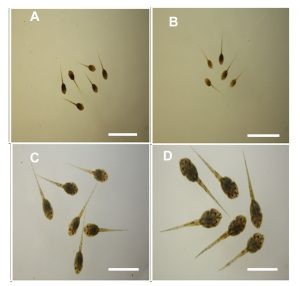To evaluate the degree of postmating isolation and the evolutionary relationships among frog species in the genus Fejervarya from Indonesia (Lesser Sunda), Bangladesh, China, and Japan, crossing experiments and molecular phylogenetic analyses were carried out. Crossing experiments revealed that reciprocal hybrids among F. iskandari, F. verruculosa, and F. sp. large type and between F. multistriata and F. kawamurai are viable through metamorphosis, while those between the F. iskandari group and F. limnocharis group were completely or partially inviable at the tadpole stage and those between Southeast Asian and South Asian Fejervarya groups were completely inviable at the embryonic stage. The mature reciprocal hybrids between F. iskandari and F. verruculosa from Lesser Sunda, Indonesia showed some degree of abnormality in spermatogenesis. In phylogenetic analyses based on mtDNA Cytb sequences, F. iskandari formed a sister clade with F. verruculosa from Lesser Sunda, Indonesia with 8.1% sequence divergence. F. multistriata from China formed a clade with populations of F. limnocharis in Thailand, Malaysia, and Indonesia (topotype) and these taxa showed sister relationships to F. kawamurai from Japan with 8.9% sequence divergence. Fejervarya sp. small type from Bangladesh formed a clade with the other South Asian members of the Fejervarya group and formed a sister clade with the Southeast Asian Fejervarya group, with 23.1% sequence divergence in the Cytb gene. These results showed that the degree of postmating isolation reflects molecular phylogenetic relationships and that F. iskandari and F. verruculosa from Indonesia (Lesser Sunda) are reproductively isolated by abnormalities in spermatogenesis and show genetic differentiation.
Figure. Twenty-day-old tadpoles of the hybrids and the controls among the Fejervarya from Asia. (A) Fkaw ♀ × Fisk ♂(K), (B) Fkaw ♀ × Fisk ♂ (E), (C) Fkaw♀ × Fkaw ♂, (D) Fmul ♀ × Fkaw ♂. Scale bar = 10 mm.

